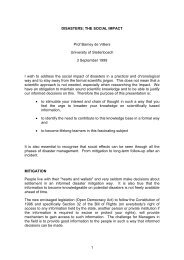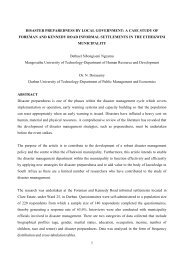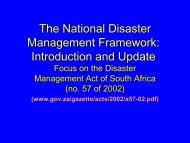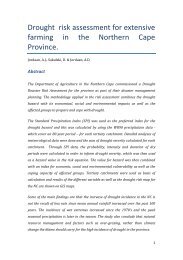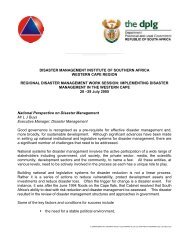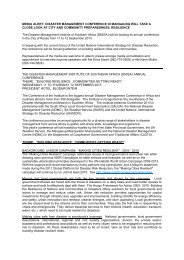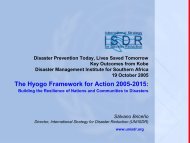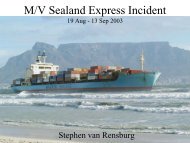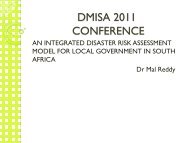Recent motion of the African plates - Disaster Management Institute ...
Recent motion of the African plates - Disaster Management Institute ...
Recent motion of the African plates - Disaster Management Institute ...
- No tags were found...
Create successful ePaper yourself
Turn your PDF publications into a flip-book with our unique Google optimized e-Paper software.
speed (upper right in Fig. 5). For GOUG, <strong>the</strong> model’s directional fit is close to perfect (lowerleft in Fig. 5), but <strong>the</strong> speed is underestimated.The NB-ITRF97 angular-velocity model <strong>of</strong> Sella et al. 8 predicts velocity vectors for SUTH,NKLG and GOUG that are rotated a few degrees clockwise from <strong>the</strong> observed velocity, andlie outside <strong>the</strong> 1-σ error limits for Vn, especially in <strong>the</strong> case <strong>of</strong> GOUG (Fig. 5). It provides a fitto <strong>the</strong> data from MAS1 (lower right in Fig. 5) that is no better than <strong>the</strong> NB-ITRF2000 result,having a clockwise bias <strong>of</strong> about <strong>the</strong> same amount as <strong>the</strong> counter-clockwise bias <strong>of</strong> <strong>the</strong> latter.However, <strong>the</strong> Canary Isles are a neovolcanic massif <strong>of</strong> probable hotspot origins, extendinginto <strong>the</strong> Atlantic Ocean from <strong>the</strong> direction <strong>of</strong> <strong>the</strong> neotectonically active High Atlas and AntiAtlas mountains <strong>of</strong> Morocco. Some question may <strong>the</strong>refore arise as to whe<strong>the</strong>r MAS1 is reallylocated on a stable part <strong>of</strong> <strong>the</strong> NB plate, or alternatively lies within <strong>the</strong> zone <strong>of</strong> influence <strong>of</strong> <strong>the</strong>EU-NB plate boundary.A comparison <strong>of</strong> <strong>the</strong> MAS1 velocity with <strong>the</strong> model vectors derived from recent EU-ITRF96and EU-ITRF97 angular-velocity models, respectively <strong>of</strong> Zhang et al. 22 and Sella et al. 8 ,shows that <strong>the</strong> EU-ITRF96 prediction fits <strong>the</strong> MAS1 data closely, whereas <strong>the</strong> improved EU-ITRF97 model is quite different.The three sites used in <strong>the</strong> present NB-ITRF2000 solution are located around <strong>the</strong> continentalmargin <strong>of</strong> south-western Africa and an eastern South Atlantic core region <strong>of</strong> Early Cretaceousoceanic lithosphere within which little or no intraplate seismic activity is recorded (Fig. 1).Consequently <strong>the</strong>ir preferred status as a 3-site “A Priori Stable Nubia Reference Frame” orAPSNuRF, following <strong>the</strong> EU plate precedent <strong>of</strong> an 8-site APSERF, 12 is tectonicallyappropriate.Velocity <strong>of</strong> <strong>the</strong> SM plateThe present, minimal, 2-site solution for <strong>the</strong> angular velocity <strong>of</strong> <strong>the</strong> SM plate (Table 1)provides an exact directional fit to observed velocities (Fig. 6) at MALI and SEY1. However,MALI moves slower than <strong>the</strong> NB-ITRF2000 model prediction and SEY1 moves faster (solidsquare symbols in Fig. 6). In both cases <strong>the</strong> model solution lies outside <strong>the</strong> 1-σ error box onboth Vn and Ve.The REVEL model (SM-ITRF97; open square symbols) is also based on <strong>the</strong> data to year2000 from only MALI and SEY1, except that <strong>the</strong> first year <strong>of</strong> data (1995-6) from SEY1 wasomitted as being “particularly noisy” (ref. 8, p. 11-26). The REVEL model velocity for <strong>the</strong>longer MALI GPS time series is a closer fit than <strong>the</strong> new SM-ITRF2000 model (Table 1),although rotated some degrees clockwise from <strong>the</strong> data, being outside <strong>the</strong> 1-σ error for Vn7



